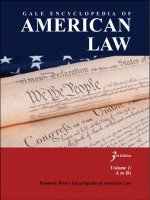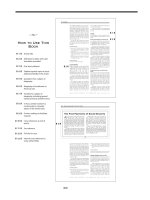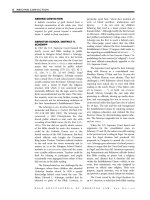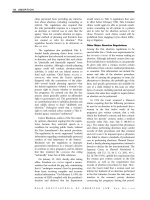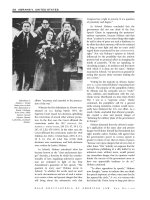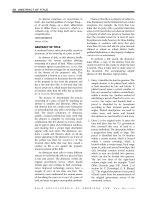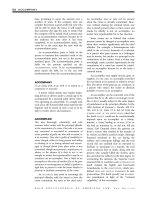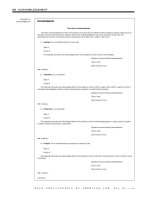Gale Encyclopedia Of American Law 3Rd Edition Volume 1 P31 ppt
Bạn đang xem bản rút gọn của tài liệu. Xem và tải ngay bản đầy đủ của tài liệu tại đây (220.62 KB, 10 trang )
In a legal argument, an analogy may be used
when there is no
PRECEDENT (prior CASE LAW close in
facts and legal principles) in point. Reasoning by
analogy involves referring to a case that concerns
unrelated subject matter but is governed by the
same general principles and applying those
principles to the case at hand.
ANARCHISM
The theory espousing a societal state in which
there is no structured government or law or in
which there is resistance to all current forms of
government.
Anarchists promote the absence of rules,
which le ads to the absence of any identifiable
social structure beyond that of personal autonomy.
When anarchy becomes defined by one anarchist,
other anarchists may feel bound to change it.
Anarchism thus means different things to
different believers. Anarchists do not hold
common views on subjects such as desirable
levels of community cooperation and the role of
large industry in society. Another matter of
continuing debate is whether anarch y is an end
unto itself or simply the best means to a better
government. To all anarchists, though, anarchy
is the best refuge f rom political dogma and
authority. Moreover, many anarchists agree that
anarchism begins with the notion that people
are inherently good, or even perfect, and that
external authority—laws, governments, institu-
tions, and so forth—limits human potential.
External authority, they suggest, brings a
corruption of the innocent human spirit and a
ceiling on achievement.
Commentators on anarchism differentiate
between “classical” theories of anarchy and
more modern movements. Classical anarchists
focused more heavily on the opposition to state
control and capitalist society. Their strongest
opposition was directed at government and the
church. Many of the early anarchists were
essentially socialists, and anarchist theories played
a significant part in the socialist movements
during the early twentieth century.
Beginning in about the 1960s, anarchism
shifted its focus to a more general opposition to
public and private hierarchy and domination of
the working class. Modern anarchists tend to focus
upon such issues as those related to patriarchy,
racism, nature, and technology, and the effects
these concepts have on society. One camp of
anarchist theorists advocates a theory of anarcho-
syndicalism, and thosethat subscribe tothistheory
promote a massive, leaderless movement of the
working class intended to take control from those
with public and private authority.
Modern anarchists directed their opposition
against such pro-capitalist and quasi-governmental
entities as the World Trade Organization,the
WORLD
BANK
, and the INTERNATIONAL MONETARY FUND.
Anarchists became the f ocus of national attention
in the late 1990s and early 2000s when they staged
massive protests against World Trade Organization
meetings in such U.S. cities as Seattle, Washington,
and Eugene, Oregon. Although anarchists
claim these protests were peaceful until law
enforcement officers disrupted them, o thers con-
sider these anarchists to be violent a nd unruly
revolutionaries.
William Godwin (1756–1836) is widely
regarded as the f irst to give anar chy a comprehen-
sive intellectual foundation. Godwin, the son of a
Calvinist minister, argued that the state and its laws
were enslaving people instead of freeing them.
According to Godwin, government was necessary
only to prevent injustice and external invasion.
With every person educated in sincerity, indepen-
dence, self-restr aint, a nd seriousness, any more
governmental activity would be unnecessary.
Godwin opposed the rise of liberal democ-
racy in the late 1700s. In the wake of the
American and French Revolutions, he observed,
“electioneering is a trade so despicably degrad-
ing, so eternally incompatible with moral and
mental dignity that I can scarcely believe a truly
On July 9, 1917,
Emma Goldman and
Alexander Berkman
were sentenced to
two-year prison terms
for violating the
Selective Service Act
of 1917.
NATIONAL ARCHIVES
AND RECORDS
ADMINISTRATION
GALE ENCYCLOPEDIA OF AMERICAN LAW, 3
RD E DITION
288 ANARCHISM
great mind capable of the dirty drudgery of suc h
vice.” Godwin’s observations and proposals
were largely ignored during his lifetime, but
they informed anarchists several decades later,
when the brutal working conditions and “wage
slavery” of industrialism began to present new
reasons for revolt.
Two well-known anarchists,
EMMA GOLDMAN
(1869–1940) and Alexander Berkman (1870–
1936), gained recognition in the 1890s. Goldman,
the daughter of Jewish merchants, immigrated to
the United States from Russia in 1885 at the age of
16. In Rochester, New York, Goldman worked in a
sweat shop—a large, unsafe factory that paid low
wages and demanded long hours. The experience
radicalized Goldman, and with her natural flair for
public speaking, she soon became a spokeswoman
for anarchism. Goldman worked extensively for
the
INDUSTRIAL WORKERS OF THE WORLD (IWW), an
organization dedicated to anarcho-syndicalism,
which seeks to use the
INDUSTRIAL UNION as the
basis for a reorganization of society. Goldman’s
cross-country lecture tours, in which she
addressedabroad range of social topics in German
and English, earned her a reputation as a witty
speaker and provocative thinker. A voracious
reader and a magazine publisher, Goldman gave
voice toideas onsexuality,freelove,
BIRTH CONTROL,
and family structures that shocked members ofher
generation, including fellow anarchists.
Like many devout anarchists, Goldman had
trouble with the law. She was imprisoned for a
year for allegedly inciting a
RIOT during a NewYork
City hunger demonstration in 1893. Goldman
also served a two-week sentence for distributing
illegal birth control information. She was jailed on
suspicion of complicity in the
ASSASSINATION of
President
WILLIAM MCKINLEY, in 1901. In 1917 she
was arrested with Berkman for participating in
antiwar protests, and both were charged with
violating the Selective Service Act of 1917 (40 Stat.
76) by inducing young men to resist the draft.
Goldman and Berkman were convicted, and,
despite appeals to the U.S. Supreme Court, both
served prison terms. Upon release in 1919, they
were deported to Russia.
Berkman, Goldman’s ally, shared Goldman’s
passion for breaking social barriers and inspiring
creative thought. He also possessed a violent
streak. In 1892 he was arrested for attempting to
assassinate steel magnate
HENRY CLAY Frick during
a steel strike. After serving a 14-year prison
sentence, Berkman devoted the rest of his life to
freeing imprisoned political radicals and pro-
moting workers’ rights. He remained a close
companion of Goldman until his death in 1936.
Goldman and Berkman cut dashing figures
as romantic, intellectual anarchists, and they
played no small part in a modest rise of
anarchism in the early 1900s. Although anar-
chism still gains followers in colleges and
universities and among self-styled intellectuals,
it has been mostly dormant as a social force
since the Great Depression of the 1930s.
Many anarchists have suffered the bemusing
fate of being convicted for breaking laws in
which they do not believe. However, the justice
system does occasionally protect the anarchist.
In Fiske v. Kansas, 274 U.S. 380, 47 S. Ct. 655,
71 L. Ed. 1108 (1927 ), Harold B. Fiske was
charged in Rice County, Kansas, with violating
the Kansas Criminal Syndicalism Act (Laws Sp.
Sess. 1920, c. 37). Fiske had been arrested for
promoting the Workers’ Industrial Union
(WIU), an organization devoted in part to
establishing worker control of industry and the
abolition of the wage system.
Under the syndicalism statute in Kansas, any
person advocating “the duty, necessity, propriety
or expediency of crime, criminal syndicalism, or
SABOTAGE is guilty of a felony” (1920 Kan.
Sess. Laws ch. 37, § 3). Criminal syndicalism was
defined as the advocation of crime, physical
violence, or destruction of property “as a means
of effecting industrial or political revolution, or
for profit” (§ 1). Kansas authorities charged Fiske
with crimina l syndicalism, citing only the
PREAM-
BLE
to the constitution of the IWW, the parent
organization of Fiske’s WIU. This preamble
stated, in part, that “a struggle must go on until
the workers of the World organize as a class, take
possession of the earth, and the machinery of
production and abolish the wage system” (Fiske).
The U.S. Supreme Court found insufficient
evidence against Fiske to
WARRANT CONVICTION of
criminal syndicalism. According to the Court,
there was no suggestion that “getting possession
of the machinery of production and abolishing
the wage system, was to be accomplished by
other than lawful means.” The Court confirmed
that a state may enact legislation to protect its
government from
INSURRECTION, but it may not
be arbitrary or unreasonable in policing its
citizens who advocate changes in the social
order.
GALE ENCYCLOPEDIA OF AMERICAN LAW, 3RD E DITION
ANARCHISM 289
FURTHER READINGS
Brailsford, Henry N. 2007. Shelley, Godwin, and their Circle
(1919). Whitefish, MT: Kessinger.
Goldman, Emma. 1970. Living My Life. 2 vols. Reprint. New
York: Dover.
Joll, James. 1979 The Anarchists. 2d ed. Boston: Little,
Brown.
Nozick, Robert. 1977. Anarchy, State and Utopia. New York:
Basic.
Sonn, Richard D. 1992. Anarchism. New York: Twayne.
CROSS REFERENCES
Chicago Eight; Freedom of Speech; Goldman, Emma;
Industrial Workers of the World; Rousseau, Jean Jacques.
ANCIENT LIGHTS
A doctrine of English common law that gives a
landowner an easement or right by prescription to
the unobstructed passage of light and air from
adjoining land if the landowner has had uninter-
rupted use of the lights for twenty years.
Once a person gains the right to ancient lights,
the
OWNER of the adjoining land cannot obscure
them, such as by erecting a building. If the
neighbor does so, he or she can be sued under a
theory ofnuisance,and
DAMAGES could beawarded.
The doctrine of ancient lights has not been
adopted in the United States because it would
greatly hinder commercial and residential
growth and the expansion of towns and cities.
ANCIENT WRITING
An original document affecting the transfer of real
property, which can be admitted as evidence in a
lawsuit because its ag ed condition and its location
upon discovery sufficiently establish its authenticity.
Under
COMMON LAW, an ancient writing,
sometimes called an ancient document, could
be offered as evidenc e only if certain conditions
were met. The document had to be at least
thirty years old, the equivalent of a generation.
It had to appear genuine and free from
suspicion. For example, if the date of the
document or the signatures of the parties to it
appeared to have been altered, it was not
considered genuine. When found, the docu-
ment must have been in a likely location or in
the possession of a person who would logically
have had access to it, such as a deed found in
the office of the county clerk or in the custody
of the attorney for one of the parties to the
writing. An ancient writing must also have
related to the transfer of real property, for
example, a will, a deed, or a mortgage. When all
these requirements were met, an ancient writing
was presumed to be genuine upon its presenta-
tion for admission as evidence without any
additional proof.
In the early twenty-first century, various state
rules of evidence and the
FEDERAL RULES OF EVIDENCE
have expanded the admissibility of ancient
writings. An ancient writing can now be offered
as evidence if its condition does not suggest doubt
as to its authenticity, if it is found in a likely place,
and if it is at least twenty years old at the time it
is presented for admission into evidence.
Some states still adhere to the requirement
that a document be at least thirty years old
before it comes within the ancient writing
exception to the
HEARSAY rule. A few states
recognize ancient documents only if, in addition
to these basic requirements, the person seeking
the admission of the ancient writing has taken
possession of the property in question.
An ancient writing is admissible in a trial as an
exception to the rule that prohibits hearsay from
being used as evidence in a trial. In a case where
no other evidence exists, the legitimacy of the
writing must be considered if the case is to be
determined on its merits. The probability that
such a document is trustworthy is determined by
its condition and location upon discovery. These
factors permit a court and a jury to presume the
authenticity of an ancient writing.
ANCILLARY
Subordinate; aiding. A legal proceeding that is not
the primary dispute but which aids the judgment
rendered in or the outcome of the main action. A
descriptive term that denotes a legal claim, the
existence of which is dependent upon or reason-
ably linked to a main claim.
For example, a
PLAINTIFF wins a judgment for a
specified sum of money against a
DEFENDANT in a
NEGLIGENCE action. The defendant refuses to pay
the judgment. The plaintiff begins another
proceeding for a
WRIT of attachment so that
the judgment will be satisfied by the sale of the
defendant’s property seized under the writ. The
attachment proceeding is ancillary, or subordi-
nate, to the negligence suit. An ancillary proceed-
ing is sometimes called an ancillary suit or bill.
A claim for
ALIMONY is an ancillary claim
dependent upon the primary claim that there
are sufficient legal grounds for a court to grant a
DIVORCE.
GALE ENCYCLOPEDIA OF AMERICAN LAW, 3RD E DITION
290 ANCIENT LIGHTS
ANCILLARY ADMINISTRATION
The settlement and distribution of a decedent’s
property in the state where it is located and which
is other than the state in which the decedent was
domiciled.
Ancillary administration occurs in a state to
enable an executor or administrator to collect
assets or to commence
LITIGATION on behalf of
the estate in that jurisdiction.
ANIMAL RIGHTS
Originally referring to the protection of animals
from cruel and inhumane treatment, the concept of
animal rights has expanded to keep pace with
scientific research confirming that many species are
sentient beings (capable of emotion and feeling, as
distinguished from perception and thought). This
awareness has led not only to a greater appreciation
and protection of animals, but also to a correlative
expansion of animal rights, even to the point of
acknowledging, but not as of 2009 fully embracing,
the concept of animals as fellow creatures with
independent rights to an unfettered existence.
Despite this growing awareness, the focus of animal
rights laws remains in the early 2000s directed
toward proscribing certai n forms of inhumane and
merciless treatment in medical and scientific
research and in the transportation, handling of,
and slaughter of animals in the meat and poultry
industries and for human consumption.
By the end of the twentieth century,
membership in animal advocacy organizations
had reached more than 10 million people in the
United States and opposition to the use of
animals in laboratory experiments was rapidly
growing. Some 76 medical schools claimed that
demonstrations and break-ins by animal rights
advocates had cost them more than $4.5 million,
according to a report from the Association of
American Medical Colleges.
As the conflict between animal rights
activists and medical and scientific researchers
has grown, federal and state regulation of
activities involving animal research has also
expanded. At the federal level, the Animal
Welfare Act (7 U.S.C.A. § 2131 et seq. [1994])
regulates the treatment of animals used in
federally funded research. Under amendments
added to the act in 1985, the secretary of
agriculture was required to
PROMULGATE stan-
dards to govern the humane handling, care,
treatment, and transportation of animals by
dealers, research facilities, and exhibitors. Thes e
standards were to include minimum require-
ments for housing, feeding, watering, sanitation,
ventilation, shelter from extremes of weather
and temperature, adequate veterinary care, and
separation by species where necessary; for
exercise of dogs, as determined by an attending
veterinarian; and for a physical environment
adequate to promote the psychological well-
being of primates. In addition, the standards
were to include requirements for animal care,
treatment, and practices in experimental pro-
cedures in research facilities.
In 1991 the Secretary of Agriculture issued
final regulations under the act (56 Fed. Reg.
6426; 9 C.F.R. § 3). Shortly thereafter, two
animal rights organizations, the Animal Legal
Defense Fund and the Society for Animal
Protective Legislation, along with several indi-
viduals, sued the U.S.
DEPARTMENT OF AGRICUL-
TURE
(USDA), claiming that the final regulations
were arbitrary and capricious, in violation of the
Administrative Procedure Act (APA) (5 U.S.C.
A. § 551 et seq. [1994]). Under the APA, a court
can compel agency action that is unlawfully
withheld or unreasonably delayed and can set
aside agency action that is arbitrary and
capricious, an
ABUSE OF DISCRETION, or otherwise
in violation of the law.
The plaintiffs challenged the USDA on
several grounds, including the lack of minimum
requirements regarding exercise for dogs and
the psychological well-being of primates; the
amount of delay permitted under the regula-
tions in complying with new cage requirements;
and the loophole in the regulations’ provision for
Members of People for
the Ethical Treatment
of Animals (PETA)
protest seal hunting.
The group has had a
significant impact on
the use of animals in
medical and scientific
research.
JENNY/WIREIMAGE/
GETTY IMAGES
GALE ENCYCLOPEDIA OF AMERICAN LAW, 3
RD E DITION
ANIMAL RIGHTS 291
special cage designs, which permitted facilities to
evade the existing minimum requirements for
cage sizes.
In February 1993 a federal district court
found that the USDA treatment of laboratory
animals waiting to be used in biomedical
experiments violated federal statutes providing
for the humane treatment of such animals. In
Animal Legal Defense Fund v. Secretary of
Agriculture (813 F. Supp. 882 [1993]), the U.S.
District Court for the District of Columbia
ruled that the regulations enacted by the
secretary of agriculture and the USDA failed
to comply with the mandate of Congress to
ensure the well-being and humane treatment of
animals.
The defendants appealed the district court’s
decision. In Animal Legal Defense Fund v. Espy
(29 F.3d 720 [1994]), the U.S. Court of Appeals
for the District of Columbia Circuit ruled that the
animal rights organizations and other plaintiffs
did not have standing to challenge the USDA.
(Standing is a legal requirement that the
PLAINTIFF
must have been injured or threatened with injury
by the action complained of and focuses on the
question of whether the plaintiff is the proper
party to bring the la wsuit.) Because the plaintiffs
lacked standing, the court ordered that the case
be dismissed.
The act was again amended (7 U.S.C.A.
§ 2132(g)) by P.L. 107–171 to expand the
definition of animal to include any warm-blooded
animal, but expressly excluded birds, rats of the
genus Rattus, and mice of the genus Mus; horses
not used for research purposes, and other farm
animals. These exclusions have been the subject of
controversy and
LITIGATION. Although the statute
required the National Research Council to submit
to the House and Senate Agricultural committees
a report summarizing the implications of includ-
ing the above-excluded species in the definition, as
of 2008, the
CONGRESSIONAL RESEARCH SERVICE had
not indicated that any existed.
Whereas the Animal Welfare Act governs
the general treatment of research animals, other
federal statutes govern the testing procedures
that may be used on animals in the course of
scientific and commercial research and in
product testing. The Toxic Substances Control
Act (15 U.S.C.A. § 2601 et seq. [1994])
authorizes the use of two procedures that have
been particularly controversial: the Draize test
and the lethal dose 50 (LD50) test.
The Draize test measures the irritancy of a
substance such as a cosmetic or pesticide by
applying it to the eyes of live rabbits for
24 hours. The LD50 test is used to calculate
the median lethal dose of a substance by feeding
it to a defined population of animals until 50
percent of them die. Some product manufac-
turers, such as Avon Products, Revlon, Faberge,
Amway Corporation, Mary Kay Cosmetics, and
Noxell Corporation, have discontinued some or
all animal testing as a result of continued
protests over the use of these tests.
The
FEDERAL BUREAU OF INVESTIGATION reported
numerous incidents of
VANDALISM annually at
research facilities and attacks on researchers
themselves. In response, the U.S. Congress and
numerous state legislatures enacted protective
legislation. In August 1992 Congress passed the
Animal Enterprise Protection Act (18 U.S.C.A . §
43 [1994]), which provides, in part, that anyone
who “intentionally causes physical disruption to
the functioning of an animal enterprise by
intentionally stealing, damaging, or causing the
loss of any property (including animals or
records) used by the animal enterprise, and
thereby causes economic damage exceeding
$10,000 to that enterprise, or conspires to do so
shall be fined under this title or imprisoned not
more than one year, or both.”
If serious bodily injury or death to another
person occurs in the course of the prohibited
activity, the statute provides for
IMPRISONMENT
up to a life term. The act defines an animal
enterprise as “(A) a commercial or academic
enterprise that uses animals for food or fiber
production, agriculture, research, or testing;
(B) a zoo, aquarium, circus, rodeo, or lawful
competitive animal event; or (C) any fair or
similar event intended to advance agricultural
arts and sciences.”
By 1995 the following states had passed
similar legislation: Alabama, Arizona, Arkansas,
Colorado, Georgia, Idaho, Illinois, Louisiana,
Massachusetts, Minnesota, Missouri, Montana,
Nebraska, New York, North Carolina, North
Dakota, Oregon , South Carolina, Tennessee,
Virginia, Washington, and Wisconsin.
Several states also regulate the use of animals
kept in pounds for use in research. Maine
prohibits the use of pound animals for any
research (Me. Rev. Stat. Ann. tit. 17, § 1025 [West
1994]). California requires that any pound or
animal regulation department where animals are
GALE ENCYCLOPEDIA OF AMERICAN LAW, 3RD E DITION
292 ANIMAL RIGHTS
turned over to a research facility post a sign
stating “Animals Turned in to This Shelter May
Be Used for Research Purposes,” in a clearly
visible place (Cal. Civ. Code § 1834.7 [West
1994]). In Oklahoma, pounds are required to
supply unclaimed animals to research institu-
tions, unless the
OWNER of an animal bringing it to
the pound specifies it is not to be used in research
(Okla. Stat. Ann. tit. 4, § 394 [West 1994]).
At least three states regulate the sale of
animals to research facilities. Minnesota law
prohibits the transfer of a dog or cat by a person
other than the owner to a research animal dealer,
the possession of a dog or cat by a dealer without
the owner’s permission, or the transfer of a dog or
cat by a dealer to an institution without the
owner’s permission (Minn. Stat. Ann. § 346.55
[West 1994]). California law provides that anyone
who steals an animal for purposes of sale, medical
research, or other commercial use, or who
knowingly defrauds another person of any animal
for purposes of medical research or slaughter,
may be imprisoned for up to one year (Cal. Penal
Code § 487g [West 1994]). New York law
prohibits the selling or giving away of a dog to a
research institution without the written permis-
sion of its owner (N.Y. Agric. & Mkts. Law § 366-a
[McKinney 1994]).
On the federal level, the Animal Welfare Act
was amended in 1990 to regulate the use of
pound animals in research. A new section titled
“Protection of Pets” provides that dogs and cats
acquired by a pound, Humane Society, or
similar entity or research facility must be held
for not less than five days before being sold to
dealers, so as to allow their recovery by their
owners or their
ADOPTION by other individuals
(7 U.S.C.A. § 2158 [1994]).
An important development in the progress
of investigation into research projects using
dealer-sourced animals was the publication, in
May 2009, of the National Research Council’s
report to Congress, Scientific and Humane Issues
in the Use of Random Source Dogs and Cats in
Research. The scath ing report asserted that,
despite new enforcement guidelines and inten-
sified in spections, the USDA could not assure
that stolen or lost pets would not enter research
laboratories via the Clas s B dealer system. (Class
A dealers sell dogs and cats specifically bred for
the purpose of research. Class B dealers possess
an operating license from the U.S. Department
of Agriculture (USDA) that allows them to
obtain dogs and cats from public animal
shelters, auctions, private individuals, and other
“random sources.”)
The report further advised that undercover
investigators had documented Class B dealers
buying pets from unlicensed persons who had
stolen animals from farms, backyards, and/or had
represented themselves as prospective adoptive
parents to animal shelters or “free to good home”
advertisers. As of 2009, 11 Class B dea lers were
registered with the USDA, two of whom were
under investigation. The published report was in
response to a request by Congress, through the
National Institutes of Health (NIH), for an
assessment of the need to use random source
dogs and cats from Class B dealers in NIH-funded
research. (The Office of Laboratory Animal
Welfare [OLAW] is maintained under an NIH
grant.) Both House and Senate had approved
amendments banning Class B dealers in a
previous congressional session, but these provi-
sions had been stripped from the final version of
the Farm Bill. An updated legislative version,
incorporating the report’s findings, was expected
to be reintroduced by Senator Daniel Akaka
(D-HI) and Representative Mike Doyle (D-PA)
in the 111th Congress (2009–2010).
The use of animals in scientific, medical,
and commercial research is expected to remain
controversial. In her book The Monkey Wars,
Deborah Blum advocated that animal rights
activists and researchers share their viewpoints
together in education programs to achieve a
realistic understanding of the issues. According
to Blum, such an understanding could end the
two sides’ long and bitter standoff.
The largest and most active animal rights
group is
PEOPLE FOR THE ETHICAL TREATMENT OF
ANIMALS
(PETA), originally founded in 1980 in
Norfolk, Virginia. Since its founding, PETA has
claimed a certain level of success in curbing
unethical treatment of animals. Its self-proclaimed
successes include the closing of the largest
horse slaughterhouse in the United States, the
closing of a military laboratory where animals
were shot, and the end of the use of cats
and dogs in wound laboratories. PETA not
only details its “victories” on its Web site,
it also provides “action alerts” that identify
instances that the group believes constitute
animal cruelty.
Although PETA has had a significant impact
on the use of animals in medical and scientific
GALE ENCYCLOPEDIA OF AMERICAN LAW, 3RD E DITION
ANIMAL RIGHTS 293
Welcome to the Monkey Lab: The
Battle over Animal Research
I
n May 1981 Alex Pacheco, cofounder
of an animal rights organization called
PEOPLE FOR THE ETHICAL TREATMENT OF
ANIMALS
(PETA), went to work as a
volunteer at the Institute for Behavioral
Research, a private research center in
Silver Spring, Maryland. Pacheco told the
institute’s chief research scientist,
Edward Taub, that he was fascinated by
animal research. Taub’s research in-
volved the surgical crippling of monkeys
using a procedure called deafferentation,
in which the spinal cord is opened and
various nerves leading to arms and legs
are sliced away, causing numbness.
At the time Pacheco joined his lab,
Taub had performed the procedure on
17 macaques, attempting to show that
function could be restored to limbs by
forcing new nerve growth. He had
destroyed the nerves to only one arm
on some of the monkeys, and then used
straitjackets, binding up the good arms to
force the animals to use their damaged
arms, and had also applied electric shock
to restrained monkeys if they did not
move their numbed limbs. Taub planned
to kill the monkeys after a year in order
to determine whether this forced move-
ment had stimulated nerve growth.
After receiving permission from Taub
to work at night, Pacheco set to work
documenting the filthy, cramped condi-
tions of the lab, and the stressed behavior
of the monkeys, many of which were
chewing their numbed limbs open. With
his PETA cofounder, Ingrid Newkirk,
stationed outside with a walkie-talkie,
Pacheco took photographs and brought
in sympathetic veterinarians and scientists
to provide affidavits about the lab condi-
tions. Several months later, he took his
documentation to the local police depart-
ment, which seized the lab’s monkeys and
filed 17 charges of animal cruelty against
Taub, under state law. The scientist was
convicted on all the charges, but an
appellate court decided that a federally-
funded researcher was not required to
comply with state laws. Eventually, Taub’s
lab lost its federal funding and discon-
tinued animal research.
Many participants in the debate over
animal rights view the 1981
SEIZURE of
the Silver Spring monkeys as a turning
point for the animal rights movement
in the United States, heading it in a
more combative and less compromising
direction.
Animal welfare has long been an issue
in the United States. As early as the mid-
1600s the Puritans prohibited cruelty
toward animals, and by the nineteenth
century groups such as the American
Society for the Prevention of Cruelty to
Animals and the American Anti-Vivisection
Society had been organized. Animal
experimentation has been controversial
not only between the animal rights
movement and the scientific and medical
research communities but also between
the activist groups themselves.
Supporters of the use of animals in
research are as adamant in their advocacy
of the use of animals in research as
animal rights activists are in their
opposition to such use. Supporters of
the use of animals in research point out
that virtually every major advancement
in medicine during the past century has
been made possible by the use of animals
in research. Researchers point out that,
with the use of animals as subjects,
scientists may be capable of curing or
reducing the death and disability rates
caused by such diseases as kidney and
liver failure, birth defects, cancer, and
AIDS. Former U.S. Surgeon General
Jocelyn Elders said, “The use of animals
in biomedical research and testing has
been, and will continue to be, absolutely
critical to the progress against AIDS and
a wide range of other applications in
both humans and animals.”
The biomedical research industry has
responded vigorously to criticisms of
animal research. A 1988 study by the
National Research Council, the research
arm of the National Academy of Sciences,
acknowledged the controversy over ani-
mal testing, stating that although animal
research has saved human lives, it has
caused suffering and death for the animals
involved. Nevertheless, the study conclud-
ed that such experimentation has contrib-
uted significantly to the increase in human
life expectancy since 1900 and that
animals have been critical to research on
most antibiotics and other drugs. Frankie
Trull, executive director of the National
Association for Biomedical Research, has
argued that animal testing is necessary to
sustain the human race.
Supporters of animal research fre-
quently direct attack towards animal
rights activists, often labeling animal
rights groups as “extremists.” Joseph
Murray, who in 1990 won the Nobel Prize
for medicine in recognition of his work on
organ transplants, said, “None of this
could have been done without animal
experimentation. It’s a tragedy and a waste
of resources that scientists have to combat
the anti-vivisectionists,” referring to ani-
mal rights groups. Animal research sup-
porters often argue that the tactics
employed by animal rights groups impede
the progress being made in the medical
community through the use of animals in
research.
The supporters of animal research
and the animal rights activists have
clashed in both the courts and in the
legislatures. Concerned that animal rights
activists would cause the dismantling of all
animal research, the biomedical research
community lobbied successfully for years
against the passage of all legislation
restricting such research. But in the early
1950s Christine Stevens founded the
Animal Welfare Institute and the Society
for Animal Protective Legislation, which
successfully worked against passage of
state laws that would require pounds to
turn their dogs and cats over to research-
ers. Stevens then began working for
passage of federal legislation that would
GALE ENCYCLOPEDIA OF AMERICAN LAW, 3RD E DITION
294 ANIMAL RIGHTS
also protect laboratory animals. In 1966,
Congress enacted the Animal Welfare Act
(7 U.S.C.A. § 2131 et seq. [1994]), which
regulates the treatment of animals in
federally funded research. Congress
charged the U.S.
DEPARTMENT OF AGRICUL-
TURE
(USDA) with overseeing the inspec-
tion of laboratories for
COMPLIANCE.
In 1985, after Stevens documented
continuing inhumane laboratory condi-
tions, the Animal Welfare Act was
amended to strengthen standards for the
humane handling, treatment, and trans-
portation of animals by dealers, research
facilities, and exhibitors. In 1991 the
secretary of agriculture issued regulations
implementing the amended act.
During this period, the animal pro-
tection movement continued to expand.
By the early 1990s PETA had grown to
more than 400,000 members and had an
annual budget of nearly $10 million. More
than 400 animal rights groups had been
organized in the United States, claiming a
total membership of 10 million. Although
each of these groups can be said to support
the humane treatment of animals, their
philosophies vary dramatically.
The most radical group is the Animal
Liberation Front (ALF), an underground
organization formed in 1982 with an
estimated worldwide membership of
several hundred as of the mid-1990s.
ALF opposes the use of all animals in
medical and scientific research, including
psychological and surgical experimenta-
tion on living animals; ALF also opposes
using animals for testing new drugs and
cosmetics, for instructional purposes in
biology and medical school classes, and
for food, clothing, sports, circuses, and
pets. ALF claimed responsibility for more
than 75 attacks in the United States
between 1979 and 1995, including steal-
ing animals from labs in Arizona,
California, Florida, Maryland, Oregon,
Pennsylvania, and Washington, D.C.;
burning and vandalizing the University
of Arizona’s veterinary lab and a new $3
million veterinary diagnostic center for
farm animals at the University of Cali-
fornia, Davis; vandalizing offices of
researchers and stealing their research
animals in Michigan and Texas; and
starting small fires in four of Chicago’s
largest department stores to
PROTEST the
sale of furs. Although most of ALF’s
targets have been scientific research labs,
the group claimed responsibility for
bombing the cars of two research
scientists in England in June 1990. ALF
has also conducted raids in more than a
dozen other countries.
By 1988, in response to raids by ALF
and other groups, more than 20 states
had enacted protective legislation prohi-
biting interference with animal research
and agricultural facilities. In August
1992, citing the inability of state and
local law enforcement agencies to con-
duct interstate or international investiga-
tions, Congress passed comparable fed-
eral legislation. The Animal Enterprise
Protection Act of 1992 (18 U.S.C.A. § 43
[1994]) prohibits the disruption of “ani-
mal enterprises” such as research facili-
ties and zoos by intentionally stealing or
damaging property including animals or
records.
Many scientists believe that ALF is a
thinly disguised division of PETA. PETA
denies any connection between the two
groups but has expressed its admiration
for ALF’s activities and often publicizes
the group’s raids. Both ALF and PETA
share a common goal of ending all
animal research, a philosophy that repre-
sents a fundamental split from other
animal rights organizations such as
Stevens’s Animal Welfare Institute and
the Humane Society of the United States,
which accept animal experimentation
but work for the humane treatment of
animals in that and other contexts.
Supporters of animal research de-
bunk many of the claims of animal rights
activities as pure myths. For instance,
animal rights activists often direct their
attention towards the use of such animals
as dogs, cats, and non-human primates
in medical research, but scientists point
out that the use of such animals accounts
for less than 1 percent of the total
number of animals used in research.
The vast majority of animals used in
research, according to these scientists, are
rodents, including mice and rats bred
specifically for the purpose of testing
them. Similarly, these scientists refute
animal rights advocates’ claims that
alternatives to animal research exist in
the form of computer models and tissue
cultures but that the scientific commu-
nity refuses to accept them. Scientists
claim that even the most sophisticated
technological model cannot replicate the
genetic and physiological systems of
humans as those found in live animals.
According to the Foundation for Bio-
medical Research, the limitations in the
use of computer models and other
alternatives may overcome the need for
animals in research, but these alternative
methods serve only as adjuncts to basic
animal research.
In a nationwide survey conducted in
December 1993 by the Los Angeles Times,
respondents were asked whether they
agreed with the following statement by
PETA’s Newkirk: “Animals are like us in
all important things—they feel pain, act
with altruism, they talk and suffer fear.
They value their lives, even if we don’t
understand those lives.” Of the 1,612
adults polled, 47 percent agreed with
Newkirk’s statement and 51 percent
disagreed. The survey also found that
54 percent opposed hunting for sport
and 50 percent opposed the wearing of
fur. Forty-six percent said the laws
protecting animals from inhumane treat-
ment were satisfactory, whereas 30 per-
cent said the laws did not go far enough,
and 17 percent said the laws went too far.
Animal rights leaders expressed surprise
that so many Americans agreed with
some of the principle tenets of the animal
protection movement.
A new wrinkle in the Animal Rights
movement has been the attempt to gain
the recognition of legal rights for ani-
mals. Animal rights advocates in both
PETA and ALF had spoken for years
about the need for animals to have legal
rights under U.S. law. But this theory
remained abstract until the end of the
twentieth century.
Then in 2000 Stephen Wise pub-
lished an influential animal rights book.
Rattling the Cage: Toward Legal Rights for
Animals took a legalistic approach in
arguing that at least two human-like
species, chimpanzees and bonobos, and
perhaps other species that were similarly
developed, should be considered
GALE ENCYCLOPEDIA OF AMERICAN LAW, 3RD E DITION
ANIMAL RIGHTS 295
research, as well as other uses, its tactics have
created an equal level of controversy. For
instance, according to PETA president Ingrid
Newkirk, human beings should not drink milk
produced by cows, eat turkey meat, or wear fur
because of the practices involved in preparing
these goods. PETA’s protests have ranged from
vandalizing fur coats sold at a Mac y’s outlet in
Boston to advocating the bombing of a New
Jersey laboratory that uses animals for research.
PETA claims that it does not support
TERRORISM,
but it did fund, for example, the legal defense of
an arsonist that set fire to a Michigan research lab.
PETA has been active in the court system,
with various levels of success. In one case, PETA
sought entry into a public art event held in 2000
in New York City called “CowParade.” One of
PETA’s entries showed a co w divided into
sections that resembled a butcher’s chart. On
each of the sections was a statement or quotation
“concerning the health and ethical problems
associated with the killing of cows for food.” The
committee responsible for the parade rejected the
entry as too harsh and inappropriate for the
parade. PETA brought suit in the U.S. District
Court for the Southern District of New York, but
the trial court granted
SUMMARY JUDGMENT in favor
of the parade organizers, and the U.S. Court of
Appeals for the Second Circuit affirmed the
summary judgment (People for the Ethical
Treatment of Animals v. Giuliani, 18 Fed. App.
35 [2d Cir. 2001]).
In 2004 and 2005 PETA engaged in an illegal
undercover investigation of a Virginia research
“persons”. The book was reviewed in
such noted publications as the Yale Law
Journal and the Harvard Law Review.
Among those legal scholars discussing
the book were
RICHARD POSNER, eminent
professor at the University of Chicago
law school and judge for the U.S. Court
of Appeals for the Ninth Circuit, and
Lawrence Tribe, professor of
CONSTITU-
TIONAL LAW
at Harvard University.
Tribe seemed especially taken with the
book’s arguments. “Broadening the circle
of rights-holders, or even broadening the
definition of persons, I submit, is largely a
matter of acculturation,” said Tribe in a
speech in Boston in support of the book.
“It is not a matter of breaking through
something, like a conceptual sound barri-
er. With the aid of statutes like those
creating corporate persons, our legal
system could surely recognize the person-
hood of chimpanzees, bonobos, and
maybe someday of computers that are
capable not just of beating Gary Kasparov
but feeling sorry for him when he loses.”
In 2002 Wise published a book called
Drawing the Line: Science and the Case
for Animal Rights, in which he expanded
his rights arguments to include other
species. But the arguments remained very
similar. “On what nonarbitrary ground,”
he asks, “could a judge find [that a] little
girl has a common-law right to bodily
integrity that forbids her use in terminal
biomedical research but that Koko [a
gorilla with an IQ equal to that of a 4- or
5-year-old child] shouldn’t have that
right, without violating basic notions of
equality?” What influence this nascent
movement for the legal rights of animals
has on the general animal rights move-
ment promised to be interesting to
observe.
Many legal commentators have been
supportive or, at least, sympathetic
toward the views of Wise and writers
with similar opinions. Other legal scho-
lars, on the other hand, have pointed out
that granting broad rights to animals
conflicts with some of the basic assump-
tions of the U.S. legal system, as well as
the legal system elsewhere. Even where
laws provide heightened protection for
animals against abuse, the animals are
still treated as a special form of property.
If the law were to extend recognition of
animals as holders of certain legal rights,
their status as something greater than
property raises difficult questions. For
instance, when would these rights con-
flict with recognized
HUMAN RIGHTS, and
could the right of an animal in a certain
case be greater than a right enjoyed by a
human? Likewise, how can society merge
the recognition of animal rights with the
traditional, and in some cases, funda-
mental uses of animals, including their
functions as sources of food and as goods
and services that may be bartered?
Scholarship and debate by legal experts
continues to grow regarding these
questions.
FURTHER READINGS
Carbone, Larry. 2004. What Animals Want:
Expertise and Advocacy in Laboratory
Animal Welfare Policy. New York: Oxford
Univ. Press.
Monamay, Vaughn. 2000. Animal Experimen-
tation: A Guide to the Issues. New York:
Cambridge Univ. Press.
CROSS REFERENCES
Cruelty.
Welcome to the Monkey Lab: The Battle over
Animal Research
(Continued)
GALE ENCYCLOPEDIA OF AMERICAN LAW, 3RD E DITION
296 ANIMAL RIGHTS
facility run by pharmaceutical giant Covance. It
then published heart-wrenching videos of mon-
keys allegedly suffering in Covance laboratories.
Covance sued PETA in 2005, alleging breach of
employment contract (regarding the undercover
employee) and
CONSPIRACY to harm the com-
pany’s business. It also sought a
GAG ORDER against
the publication of the videos, photographs, and
statements. A
SETTLEMENT was reached in 2005, in
which PETA agreed not to infiltrate Covance
facilities and Covance tendered a monetary
settlement amount (Covance Laboratories Inc. v.
People for the Ethical Treatment of Animals,
No. CH-2005-2590,
CIRCUIT COURT for the County
of Fairfax, Virginia [2005]).
FURTHER READINGS
Bekoff, Marc. 2009. Encyclopedia of Animal Rights and
Animal Welfare. 2d ed. Westport, CT.: Greenwood
Press.
Blum, Deborah. 1995. The Monkey Wars. Don Mills, ON,
Canada: Oxford Univ. Press.
Congressional Record. 1990. 136 (July).
Congressional Research Service (CRS). 2008. Brief Summa-
ries of Federal Animal Protection Statutes. 94-731.
Washington, D.C.: National Academies Press.
Humane Society of the United States. 2009. “Class B. Dealer
System Unnecessary and Unenforceable, According to
National Academies Report.” May 29. Text available
online at h ttp://www .hsus.org/ /class_b_dealer_ system_
unnecessary_052909.html; website home page: http://www.
hsus.org/ (accessed August 5, 2009)
Kistler, John M. 2000. Animal Rights: A Subject Guide,
Bibliography, and Internet Comparison. Westport,
Conn.: Greenwood.
National Research Council. 2009. Scientific and Humane
Issues in the Use of Random Source Dogs and Cats in
Research. Washington, DC: National Academies Press.
Sherry, Clifford J. 1994. Animal Rights:A Reference Handbook.
Santa Barbara, Calif.: ABC-CLIO.
Singer, Peter. 1975. Animal Liberation: A New Ethics for Our
Treatment of Animals. New York: Avon.
CROSS REFERENCES
Agriculture Department; Criminal Action; Cruelty; People
for the Ethical Treatment of Animals.
ANIMUS
[Latin, Mind, soul, or intention.] A tendency or
an inclination toward a definite, sometimes
unavoidable, goal; an aim, objective, or purpose.
When animus is used in conjunction with
other words of Latin origin, its most common
meaning is “the intention of.” For example,
animus revocandi is the intention of revoking;
animus possidendi is the intent ion of possessing.
Animo, meaning “with intent,” may be
employed in a manner similar to animus. For
example, animo felonico means with felonious
intent.
ANNEXATION
The act of attaching, uniting, or joining together
in a physical sense; consolidating.
The term is generally used to signify the
connection of a smaller or subordinate unit t o a
larger or principal unit. For example, a smaller
piece of land may be annexed to a larger one.
Similarly, a sma ller document may be annexed
to a larger one, such as a
CODICIL to a will.
Although physical joining is implied, actual
contact is not always necessary. For example, an
annexation occurs when a country acquires new
TERRITORY even though the new territory is not
immediately adjacent to the existing country.
In the law of real property, annexation is
used to describe the manner in which a chattel
is joined to property.
CROSS REFERENCE
Fixture.
ANNOTATION
A note, summary, or commentary on some section
of a book or a statute that is intended to explain or
illustrate its meaning.
An annotation serves as a brief summ ary of
the law and the facts of a case and demonstrates
how a particular law enacted by Congress or a
state legislature is interpreted and applied.
Annotations usually follow the text of the
statute they interpret in annotated statutes.
ANNUAL PERCENTAGE RATE
The actual cost of borrowing money, expressed in
the form of a yearly measure to allow consumers
to compare the cost of borrowing money among
several lenders.
The Federal Truth-in-Lending Act (15 U.S.
C.A. § 1601 et seq. [1968]) mandates the
complete disclosure of this rate in addition to
other credit terms.
CROSS REFERENCE
Truth in Lending Act.
ANNUAL REPORT
A document published by public corporations on a
yearly basis to provide stockholders, the public,
GALE ENCYCLOPEDIA OF AMERICAN LAW, 3RD E DITION
ANNUAL REPORT 297

